Van Conversion Layouts: Tips for Choosing a Floor Plan
Get advice for planning your camper van conversion layout based on your personal priorities, so you end up with a functional van floor plan.
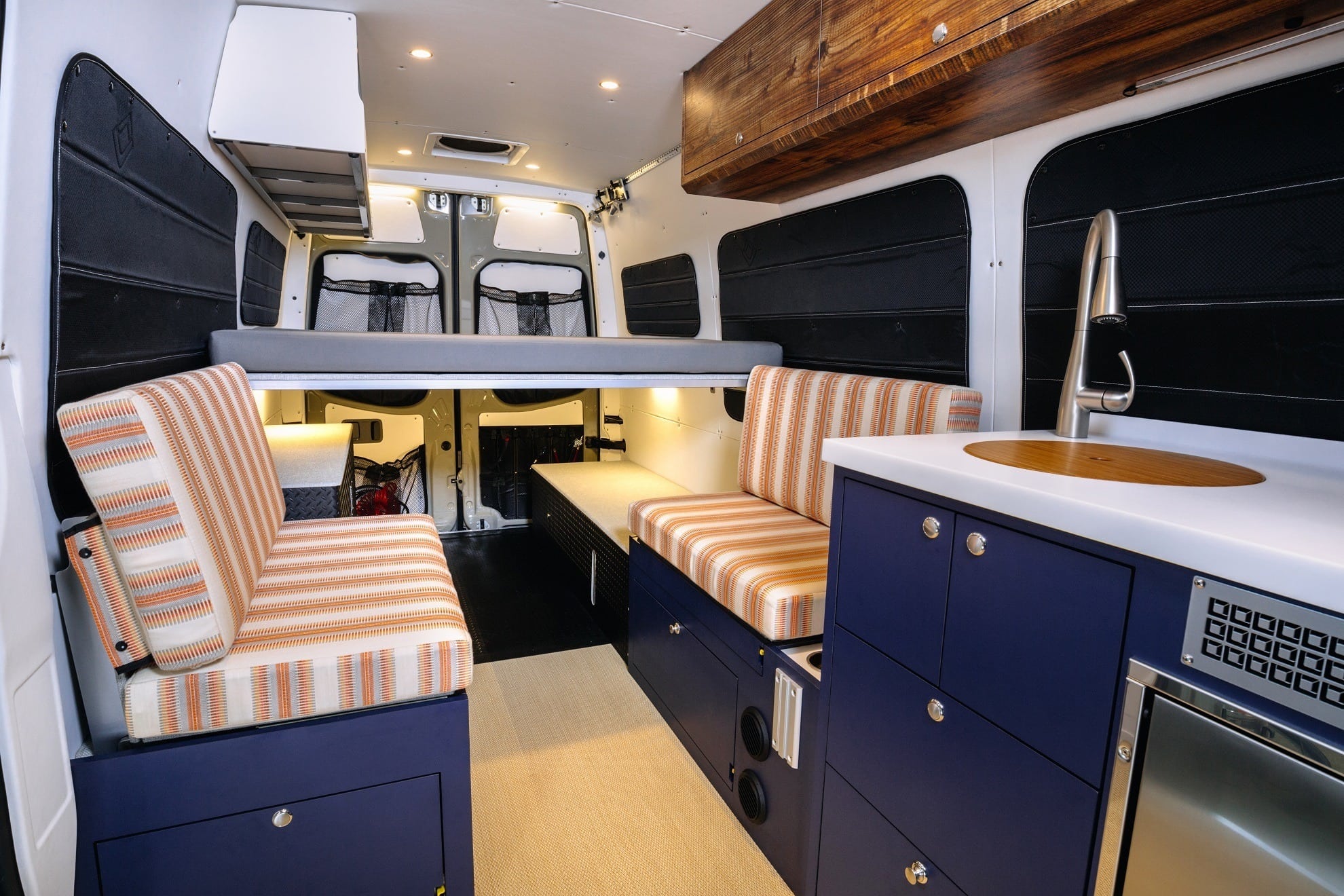
The most important decision you’ll make in the van conversion process is choosing the right camper van layout. This is a process that requires a lot of careful thought and evaluation and shouldn’t be rushed – because once your van is built, the layout can’t be easily changed.
In this blog post, I pose some questions to help you nail down your priorities for your camper van layout, as well as share some important tips for making sure you get your van floor plan right.
Plan the perfect van conversion layout with the tips below!
This post may contain affiliate links.
Planning Your Van Conversion Layout Video

Save this post!
Enter your email & I'll send this post to your inbox! You'll also receive my weekly newsletter full of helpful advice for planning your adventures.
Determining Your Priorities for Your Van Conversion Layout
With less than 100 square feet of living space, you need to decide what gear and other items you want to have in the van, and what you will be using the van for in order to determine what layout will work for you. By narrowing down your priorities, you’ll ensure that your build will accommodate everything you need and want while efficiently using the space.
Before you dive into planning your van conversion and layout, first you’ll need to rank your priorities and decide what’s most important to you. To help you get the wheels turning, download our free “Evaluating Your Lifestyle Worksheet” below and fill out your answers to get an idea of what might be the best van for you.

Freebie!
Evaluating Your Van Lifestyle Worksheet
Get this free PDF worksheet to help you determine your priorities for your camper van conversion.
Think about your current day-to-day lifestyle and make a note of what’s important to you. Living out of a van on the weekend or traveling and living in it full-time does mean you’ll have to sacrifice some creature comforts, but not all of them. If waking up in the morning and having fresh espresso is something you savor, make that a priority. If having a designated toilet area is a must, add it to the list.
What’s important to one van dweller might not be important to another. It helps to visualize your ideal day from start to finish – what do you do upon waking up? How does the rest of the day go? What sort of living space will you be comfortable in, not just for a couple of days, but for a long time? Do you care more about storing mountain bikes or having an enclosed shower? A permanent bed or a big dinette where you can entertain? A nice big galley or a big workspace? A shorter, more maneuverable van or more interior space?

Tip: Not sure what kind of van you want? This blog post breaks down the differences between the most popular types of vans for van life including Sprinters, Promasters, Transits, VWs, and other common vans.
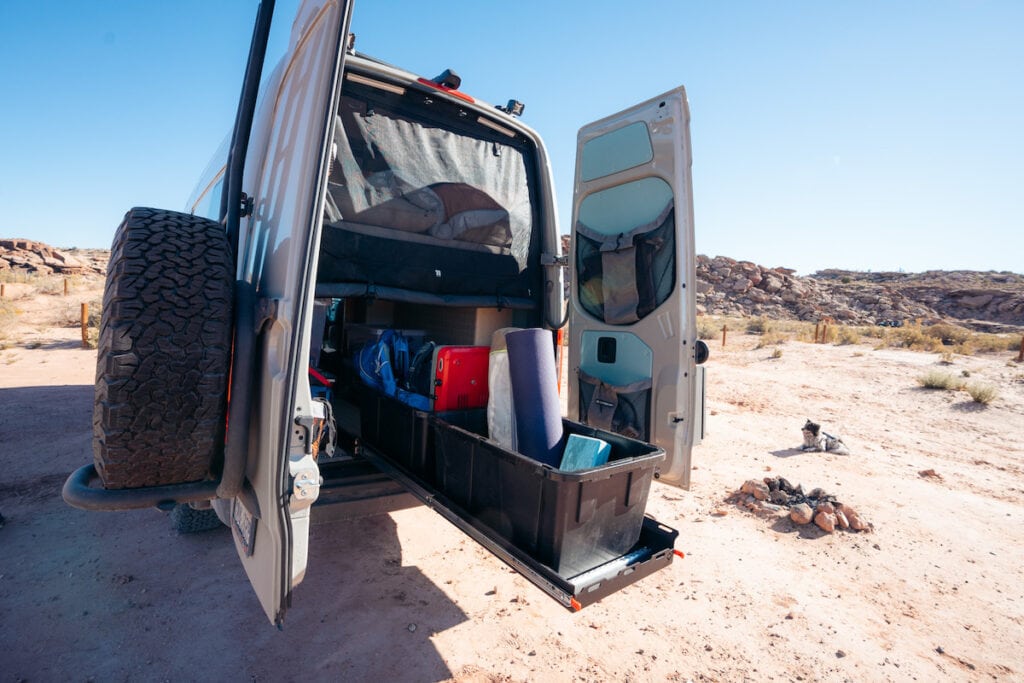
Maximizing Interior Space
Before we get into the different factors that go into determining the best layout for your van conversion, one option to help maximize interior space in your van and open up additional layout options is to install Flares that bump out the rear side panels near your bed.

Flares widen the space at the rear of the van so your bed can be installed sideways (wall to wall) instead of lengthwise. Flares are available for 144″ and 170″ Sprinter Vans, as well as select Promasters, Ford Transits, Ford E-Series Vans, and a few other types of vans.
While planning your van layout, if you’re having a difficult time fitting everything you want or you simply want to maximize the usable space in your van, you may want to consider Flares.
I don’t have Flares in my current van, but if I were going to convert another Sprinter Van, I would consider Flares now that we are traveling with our baby which requires an additional seatbelt. Our van’s layout feels a lot tighter than it did pre-baby, and Flares would certainly open up the inside of our van, making it more spacious.
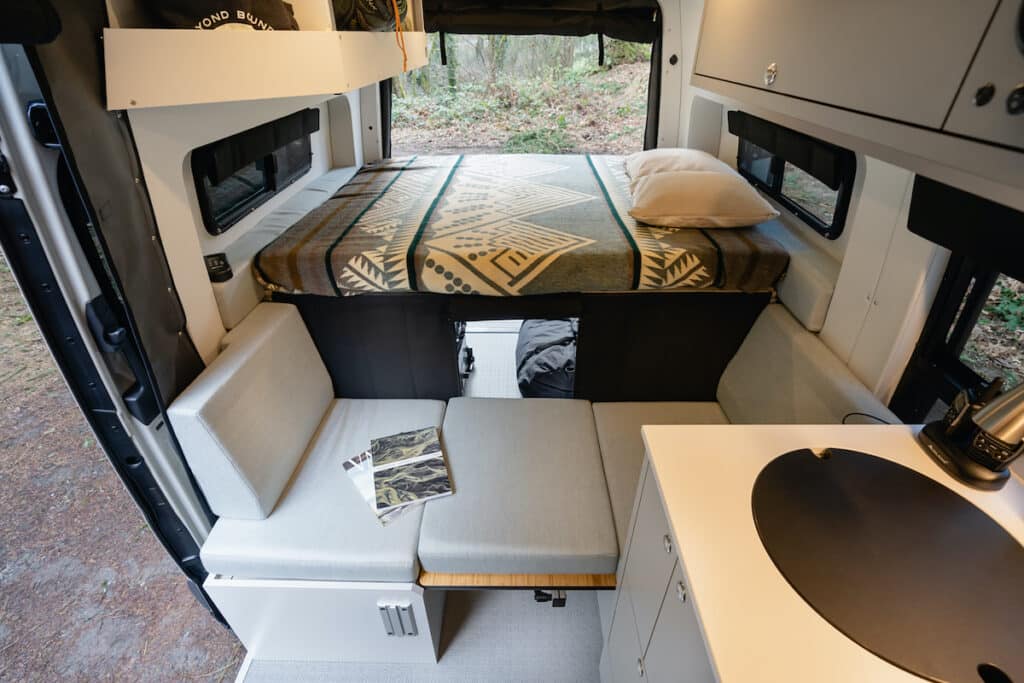

Van Weight Considerations
Something that is often overlooked when planning your van layout is the need to keep the van’s payload and weight capacity in mind. This is essential during the planning stage to ensure you don’t overload your van by using super heavy build materials. You’ll also want to ensure the weight is evenly distributed across your van.
For instance, you want to keep your water on one side of your van and your electrical system on the other side since those are typically two of the heaviest items in a van build. You’ll also want to leave some room for the weight of your van when it’s fully loaded with people and all of your gear. Learn more about van payloads and weight considerations here.
Storage for Van Life Gear
Now, let’s move on to storage space. Gear takes up a lot of room in the van, so as part of the van conversion planning process, you should make a list of everything you want to bring with you. Yes, everything. Then, ask yourself, “How often do I use these things at home?”
If you never kayak at home because it’s a hassle, you probably won’t kayak much in the van. Sure you’ll have more access to places to kayak, but it still requires shuffling things in your van around and taking the time to make it a priority.
For instance, last summer we had two big inflatable paddle boards in the van. Every time we wanted to go paddleboarding, it took an hour to pull the boards out, inflate them, get ourselves situated, and then carry them down to the water (not to mention deflating them and putting them away). As it turns out, we didn’t end up using them all that much, and those big boards took up valuable space that could have been used for something else. So I recommend thinking hard before you add every idealistic item to your list.
Below is a starter list of gear you might want to bring along to get you pointed in the right direction. Be selective about what’s truly important to you that brings the most joy to your life. You’ll be surprised how quickly gear and even clothing can add up in your van, so make a list of your own and start narrowing it down.
Van Life Gear
- Bikes
- Backpacking Gear
- Packrafts
- Kayaks
- Paddleboards
- Camp Chairs
- Camp Table
- Cooking Stuff
- Food
- Computer / Camera / Electronics
- Fishing Gear
- Clothing
- Shoes
- Yoga props
- Trash cans (commonly forgotten about, but take up a lot of space)
One thing to keep in mind when designing your van layout is how big your gear is. Planning on hauling bikes? You either need to have a fixed bed so you can store the van underneath, or plan to install a bike rack on the back of your van. You can learn more about bed options for your van layout here.
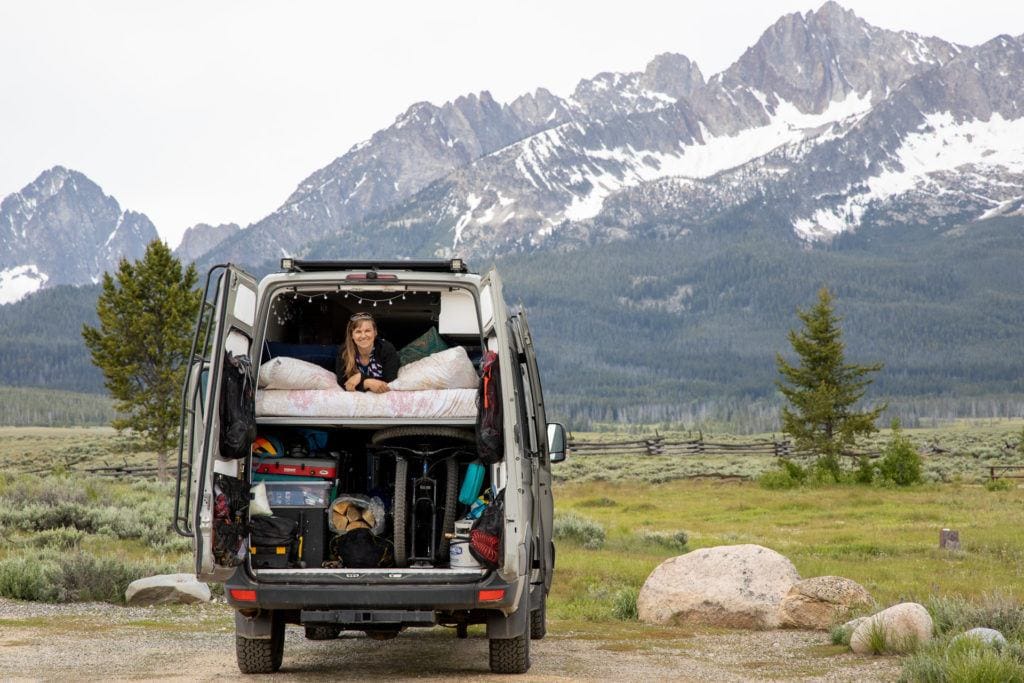
As a bonus, you can download my full van packing checklist below. I encourage you to go through this item by item and create your own packing checklist based on your priorities.
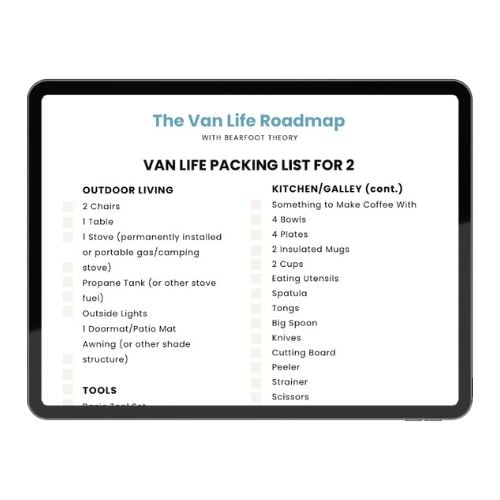
Freebie!
Van Life Packing Checklist
Get this free PDF that will help you pack up your van in a jiffy.
Deciding on Your Van Conversion Layout
Deciding on your ideal floor plan is one of the biggest choices to make in the early stages of planning. One floor plan is not superior to another – it’s truly a matter of preference and what will work for you based on what sort of lifestyle you’ll be living.
The common questions that come up around a van’s floor plan usually revolve around storage, bed style, number of people, and personal preferences. So, spend some time visualizing your day-to-day in different floor plans and decide what will be best for you. When thinking through your campervan conversion priorities, I suggest prioritizing a functional floor plan over an aesthetically pleasing one.
Here are a few questions and resources to help you decide which van conversion layout will work for your everyday needs:
Will you be traveling solo, as a couple, or as a family?
Camper vans are small, and the layout that works best for a solo traveler is going to look a lot different than the best layouts for a family. I planned my first van’s layout as a solo van-lifer, but after I met my partner Ryan, I realized that layout was not the best fit for a couple.
Some things to keep in mind based on the number of people in your van are how much storage you need, where you will lounge and sit, and how big of a bed you will need.
Do you want a built-in bathroom with a shower, just a toilet, or no bathroom at all?
Whether or not to include an indoor shower and/or toilet in your van is a hotly debated and deeply personal choice. If you need to have a toilet, you need to have a toilet. We have tons of resources to help you decide on what kind of bathroom setup will work best for your van conversion layout:
- Camper Van Bathroom Ideas for Your Conversion
- Best Campervan Toilet Options & What to Do If You Don’t Have One
- Pros/Cons: Sprinter Van Bathroom
- 7 Reasons Why You Don’t Need a Shower Inside Your Van
Where and how do you plan on cooking? What appliances do you need?
The two biggest considerations when it comes to planning your van kitchen are designing a layout and choosing appliances. What will your kitchen galley look like? How big of a fridge do you need? How much counter space do you want? Do you want a fixed stove? Do you want the ability to cook outside?
What kind of bed do you want?
There are several different camper van bed configurations to consider for your van layout, and deciding which is best for you depends on a few things. How many people are going to be sleeping in the bed? How tall are the people sleeping in the bed and what direction do you need to sleep in to be most comfortable? Do you want a permanently fixed bed or a convertible bed?
Do you have a pet coming along?
Van life with a dog is awesome, but it also requires pre-planning in your design stage to make sure you have enough space in your van to accommodate things such as their water and food bowl, storage for their extra food, and a spot for them to sleep. Traveling with a dog? Check out our tips for van life with a pet.
Common Van Bed Styles
Selecting a bed style will influence the rest of the van conversion layout, so spend some time weighing the pros and cons of different bed styles before planning the rest of your floor plan. As I mentioned above, your decision on whether or not to add Flares to your van build will influence your bed and layout options as well. If you do go with Flares, you can make your conversion easier by adding one of the Flarespace bed systems.
Decisions about your bed will be closely followed by whether or not to have a bathroom and the size of your galley.
Here are three of the most common van bed styles:
Fixed Bed
A fixed bed is typically a raised platform in the back of the van that allows for a ton of storage space in the garage. This is probably the most popular van bed style and what I chose for my second and thrid Sprinter van – both converted by Outside Van – since I wanted to be able to haul a lot of gear. Another pro to having a fixed bed is that you don’t have to worry about converting your bed into a workspace or eating area. The biggest downside to a fixed bed is that you don’t have a lot of space to host others in your van and you’ll have to get creative about a workstation.
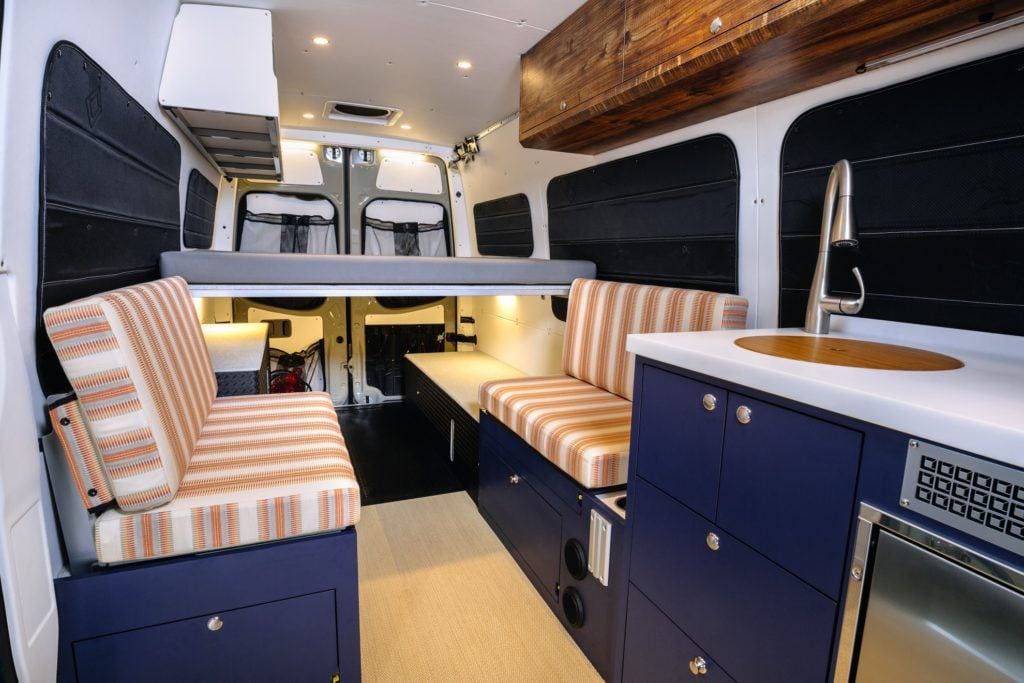
Convertible Bed
Having a convertible bed that transforms into a couch or into a small dining space with two benches is a great option if you want to be able to have a large workspace or dining area to host others in your van. There is a lot of storage space available with convertible bench seats, although it’s a much smaller area than a fixed bed would give you, and doesn’t allow for as many big gear items like inflatable kayaks or bikes. Additionally, it can be difficult to access bench storage. Still, this is a super common van bed style and comes down to personal preference.
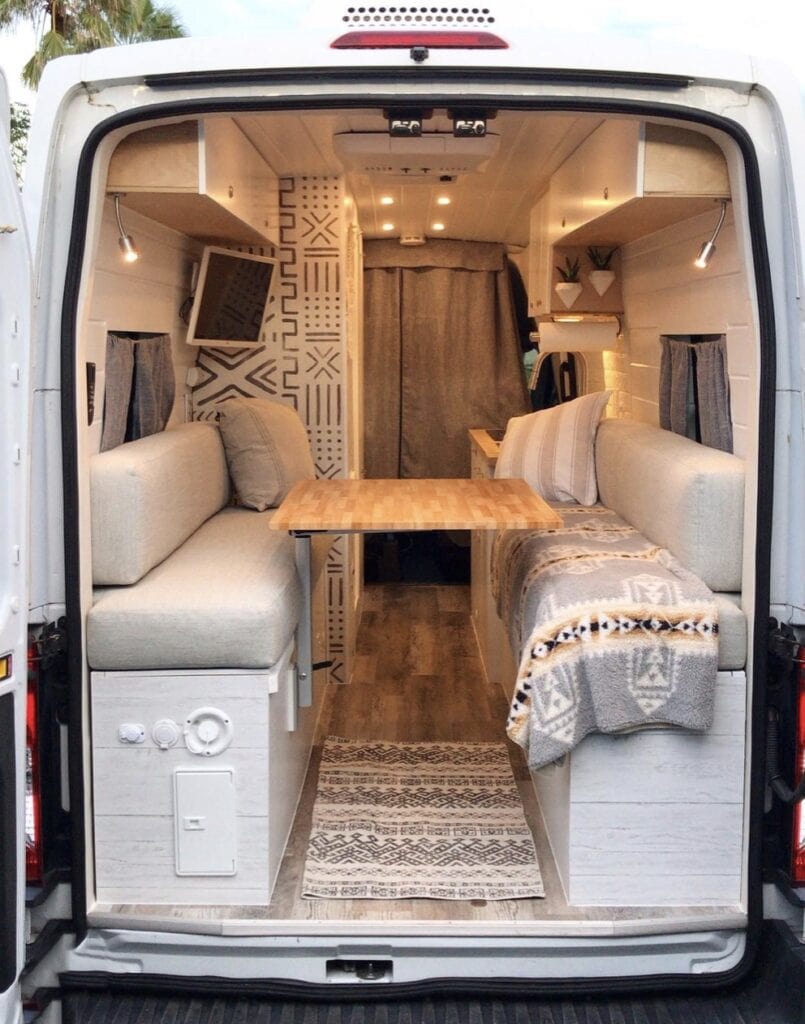
Murphy Bed
Murphy bed designs are starting to gain a bit of traction, although it’s still the least common bed style to see on the road. A Murphy bed is on a platform that is raised and lowered, giving you seating and a table without having to totally disassemble and reassemble your bed every time. It’s not a simple design (hence why it’s not very common), but for people who don’t want the hassle of pulling apart your bed every time you want to have a larger seating area, this is an awesome way to do it.
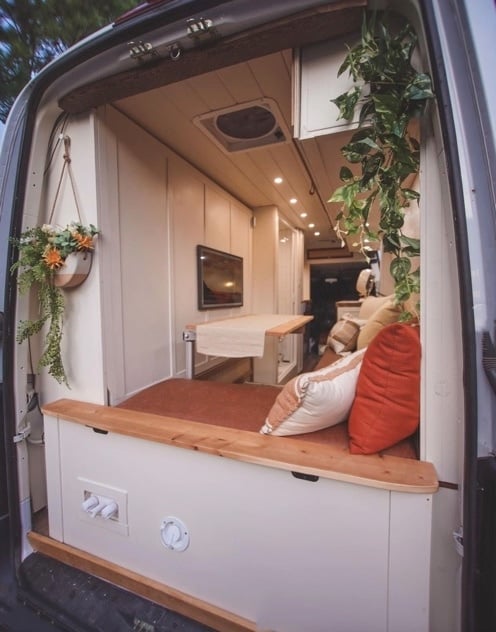
You can see more camper van bed ideas and examples for your conversion here.
How Do You Decide on the Right Van Conversion Layout?
1) Travel in your van empty before you decide on a floor plan
At first, all you really need in your van is an air mattress, sleeping bag, camp stove, and cooler. Hit the road with your essentials and see how you are using the van. I was sure I needed a shower in my van in my first van, but in 2 years, I only used the shower a handful of times. Had I taken a few road trips in my van before building it out, I may have realized it wasn’t as necessary as I thought. You’ll also see how much off-roading you are doing. If you find yourself mostly on dirt roads, you’ll want to consider that as you are deciding on materials and weight inside your van.
Another great thing to do when your van is empty is to draw out your potential layout with painter’s tape on the floor, or better yet, use some cardboard to mock up the space to get a clear picture of how your design ideas fit into the van.
2) Go to a Van Gathering
I wish I had gone to a van festival or gathering before I built out my first Sprinter Van. By attending an event with a ton of vans and cool, like-minded people, you’ll get a ton of ideas, inspiration, and advice for the best camper van layouts. Be sure to check out our own van festival – Open Roads Fest – where there are tons of rigs and workshops to help you learn and plan for your van build.
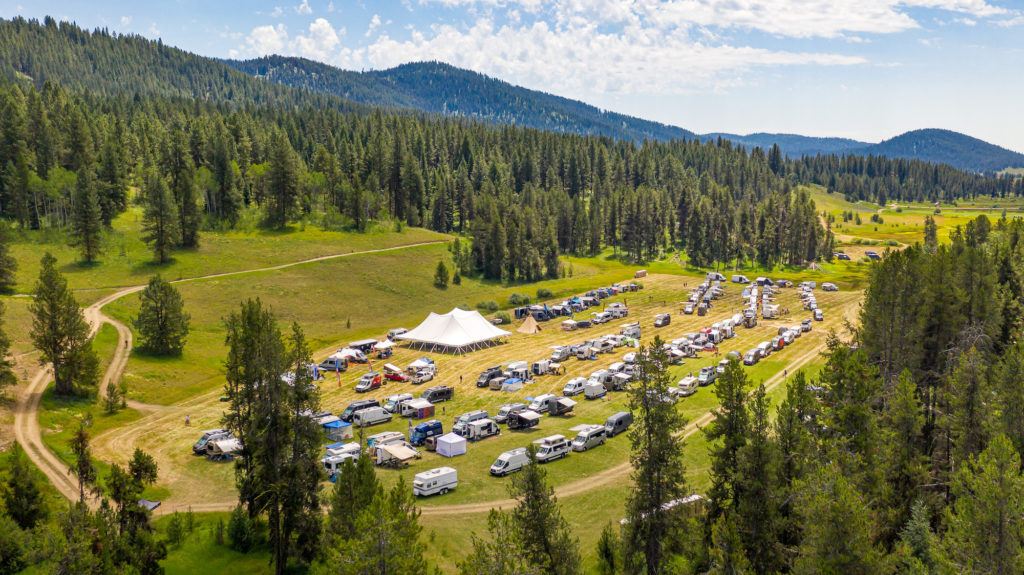
3) Join the Sprinter forums and Facebook Groups
The Expedition Portal and the Sprinter Source are two examples of great forums where you can ask questions, check out van builds, and get all kinds of ideas for your design. There are also dozens of free groups on Facebook now as well. I recommend you join these before you start your conversion process so you can learn from a variety of people who have been there, done that.
4) Rent a camper van to test
Renting a camper van (or two) is one of the best ways to quickly figure out what works for you. Everyone’s van needs are different, and usually, they also change once you hit the road and get a feel for what life on the road really feels like. By renting a van for a quick test trip, you can decide if a certain layout is for you. Unsure if you want to convert your bed from a dinette to bed every day? Unsure if you can live without a toilet and shower? Check out our comprehensive guide to camper van rental companies to help you plan your camper van layout.
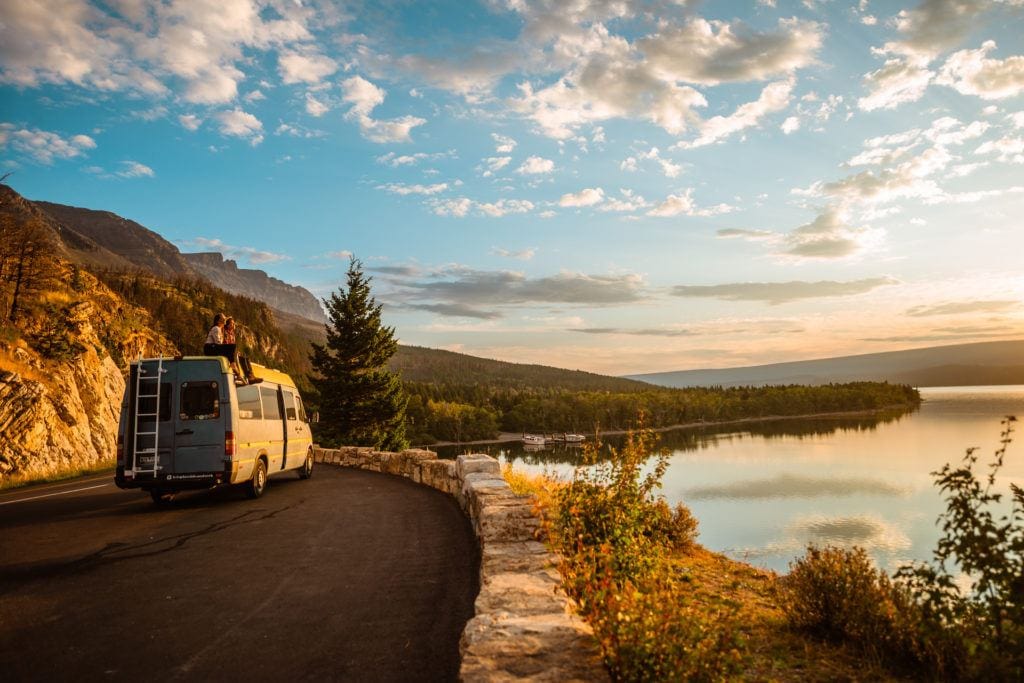
5) Check out the website and social channels of custom van builders
Even if you plan to DIY, follow a number of custom van builders and dig through their websites to get new ideas you hadn’t thought of. Companies like Outside Van and others have been building out vans for a long time and have a wealth of information. They know what works and what doesn’t, and they use the tried and tested products in their own conversions. On Instagram, search hashtags like #vaninterior #vanbuild and #diyvanconversion to find tons of awesome inspiration.
6) Think about the long-term
How you use your van now might be different than a year from now. For instance, when I bought my van and started building it, I was single. Now I’m in a relationship with my boyfriend Ryan, and we have two dogs. I quickly outgrew my original floor plan. My advice is to think about the future (ie will you have kids or a partner within a few years) and make sure your floor plan is appropriate for whatever direction your life might go.
7) Prioritize a functional van floor plan before aesthetics
Of course, you want a beautiful van that fits your style. No matter what you decide for your Sprinter Van floor plan, you can always put some nice finishing design touches on your van that speaks to your personality. But making room in the right place for your water tanks, electrical system, and functional elements is the first step, and you shouldn’t even start thinking about aesthetics until you have the inner workings figured out.
What questions do you have about van conversion layouts? Share your questions, tips, and experiences in the comments below.

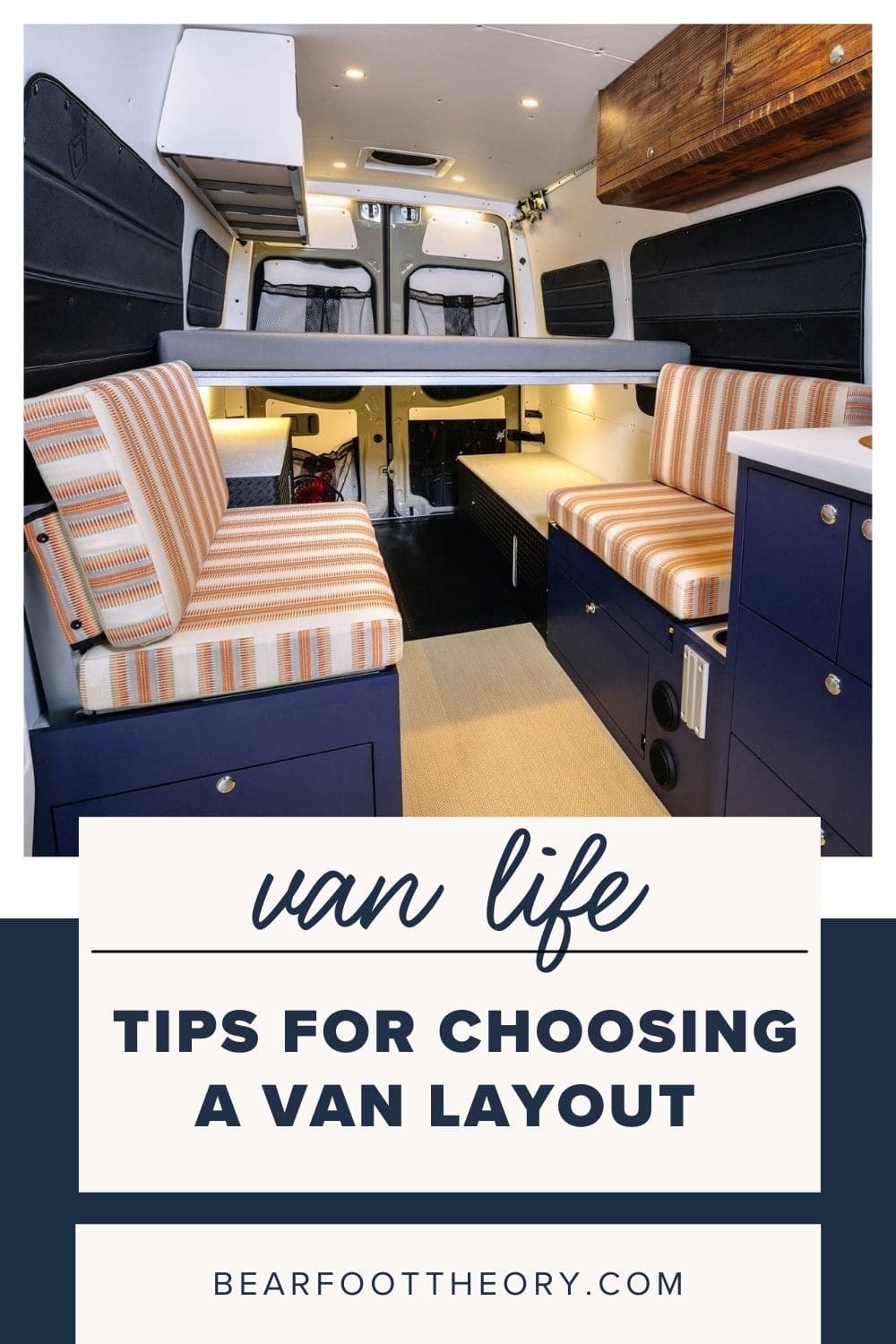
2003, we converted a 1997 Ford CF8000 commercial truck to our concept of an ExpeditionVehicle.
Looking at a bare box, we crafted cardboard furniture.
Placing these in different configurations, we determined traffic flow, window cut-outs, and the absolute minimum of ‘hall’ walkway.
Shelves and bed-frame and seating are all modular, and are easily re-arranged.
After nearly two decades of full-time live-aboard — boondocking exclusively — our rig is constantly evolving.
Suggestion:
* avoid the trap of believing ‘this rig is my forever rig’.
I want a space to sleep when ever the mood hits me. I’m traveling solo so the space could be utilized in creative ways. I’m a petless traveler that have friends scattered far and wide. Arizona,California,washinton state Montan a Wisconsin,Michigan and Virginia and as this virus dies down I plan to see them all at least one more time. The remnants of the best platoon in 4th Marines. I have a Ford Transit F-350 and I will time my visits to the northern tier states for spring and summer and winter in the southwest. It was originally a 17 passengers van and I was wondering what you recommend for insulation for all the Windows its a fish bowl. Built customized decks for summer money while teaching high schoolers to draw for 27 years. I happen to have a lot of cypress lumber that I can use. Any recommendations would be appreciated.
Hi Mike – check out our post on Van Insulation!
Hi have you tried a 12volt electric blanket you can get them off the internet cheep and their fairly efficient and warm and totally worth it